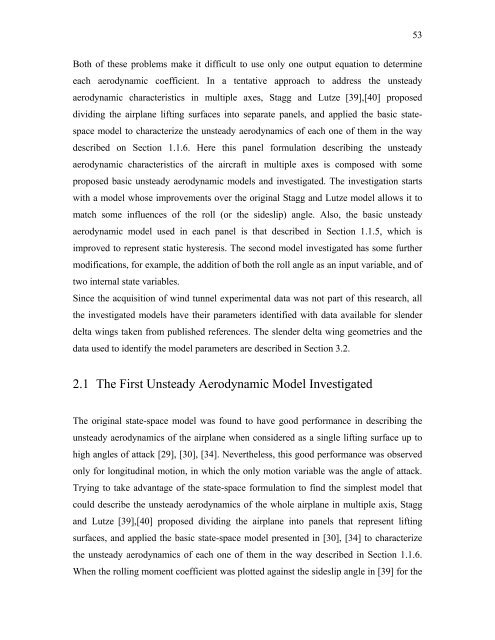Aircraft Stability Analysis Including Unsteady Aerodynamic Effects
Aircraft Stability Analysis Including Unsteady Aerodynamic Effects
Aircraft Stability Analysis Including Unsteady Aerodynamic Effects
Create successful ePaper yourself
Turn your PDF publications into a flip-book with our unique Google optimized e-Paper software.
53Both of these problems make it difficult to use only one output equation to determineeach aerodynamic coefficient. In a tentative approach to address the unsteadyaerodynamic characteristics in multiple axes, Stagg and Lutze [39],[40] proposeddividing the airplane lifting surfaces into separate panels, and applied the basic statespacemodel to characterize the unsteady aerodynamics of each one of them in the waydescribed on Section 1.1.6. Here this panel formulation describing the unsteadyaerodynamic characteristics of the aircraft in multiple axes is composed with someproposed basic unsteady aerodynamic models and investigated. The investigation startswith a model whose improvements over the original Stagg and Lutze model allows it tomatch some influences of the roll (or the sideslip) angle. Also, the basic unsteadyaerodynamic model used in each panel is that described in Section 1.1.5, which isimproved to represent static hysteresis. The second model investigated has some furthermodifications, for example, the addition of both the roll angle as an input variable, and oftwo internal state variables.Since the acquisition of wind tunnel experimental data was not part of this research, allthe investigated models have their parameters identified with data available for slenderdelta wings taken from published references. The slender delta wing geometries and thedata used to identify the model parameters are described in Section 3.2.2.1 The First <strong>Unsteady</strong> <strong>Aerodynamic</strong> Model InvestigatedThe original state-space model was found to have good performance in describing theunsteady aerodynamics of the airplane when considered as a single lifting surface up tohigh angles of attack [29], [30], [34]. Nevertheless, this good performance was observedonly for longitudinal motion, in which the only motion variable was the angle of attack.Trying to take advantage of the state-space formulation to find the simplest model thatcould describe the unsteady aerodynamics of the whole airplane in multiple axis, Staggand Lutze [39],[40] proposed dividing the airplane into panels that represent liftingsurfaces, and applied the basic state-space model presented in [30], [34] to characterizethe unsteady aerodynamics of each one of them in the way described in Section 1.1.6.When the rolling moment coefficient was plotted against the sideslip angle in [39] for the
















